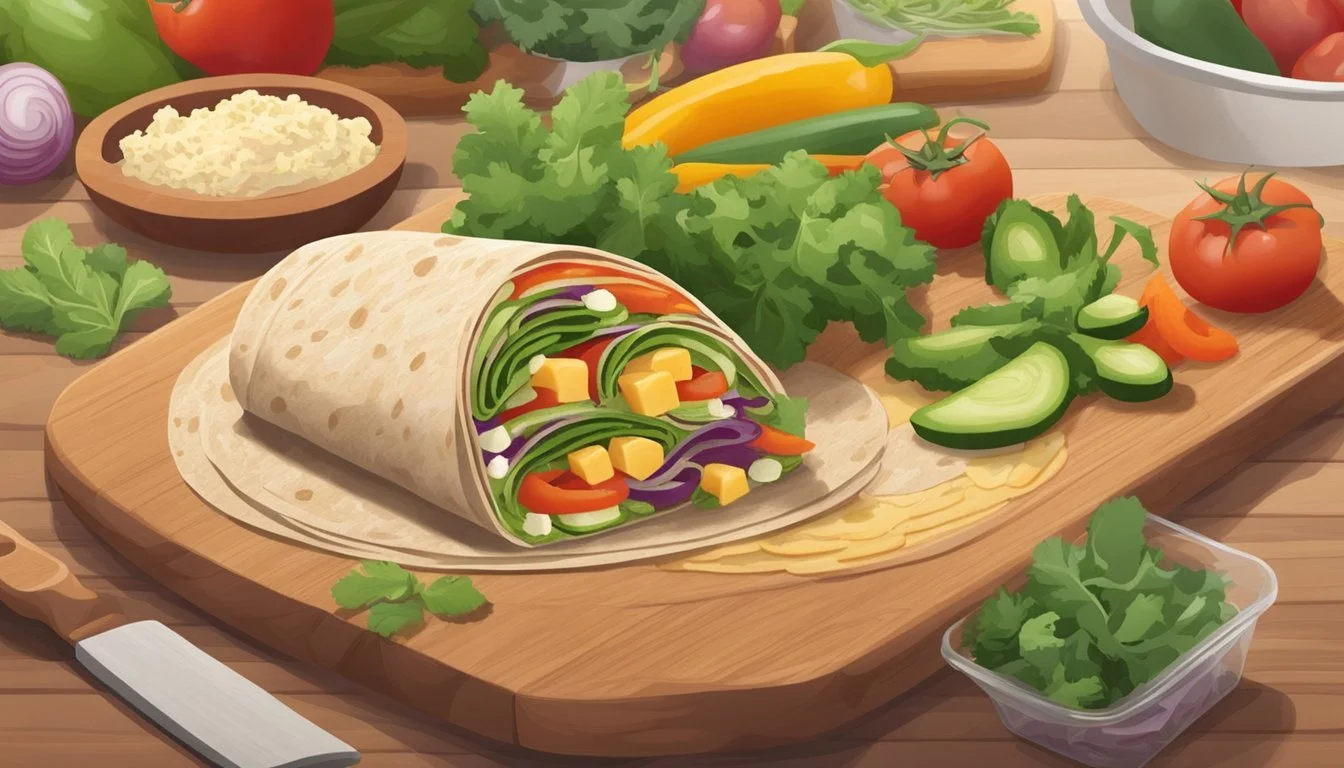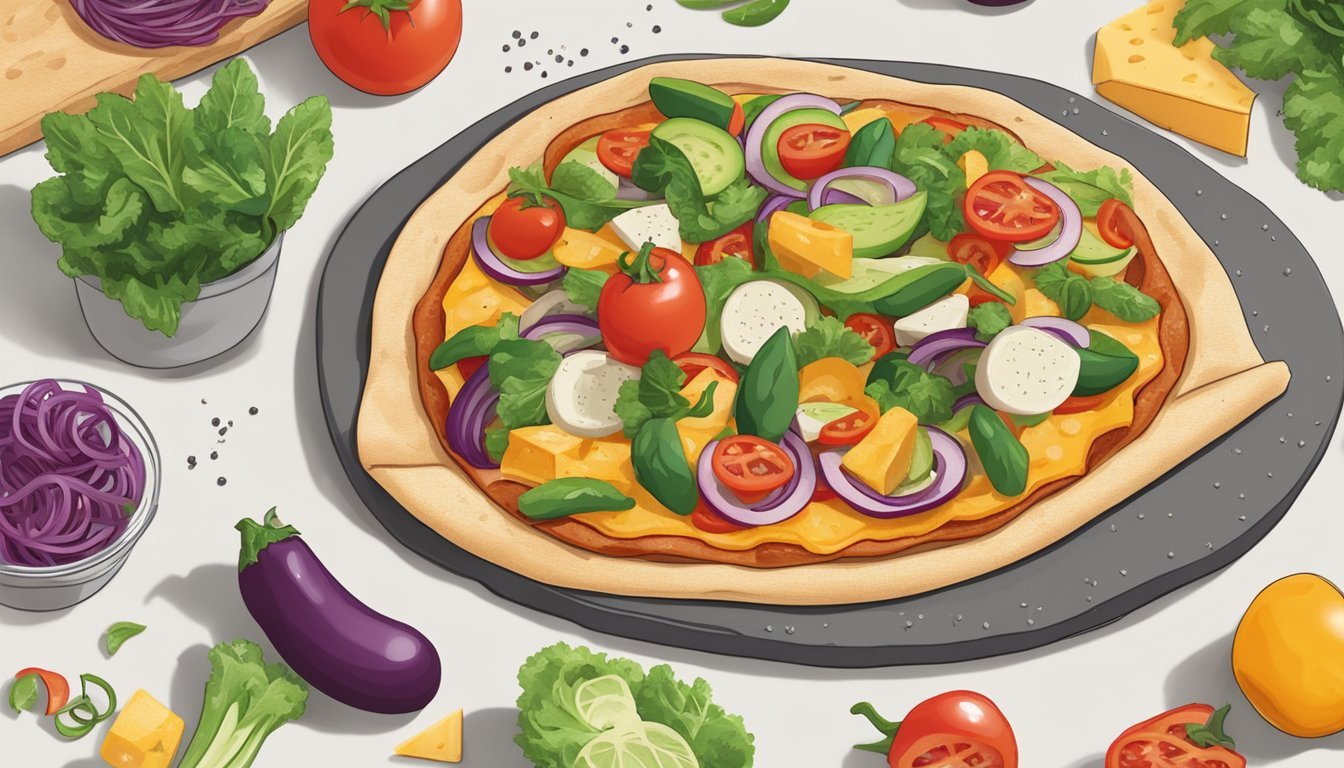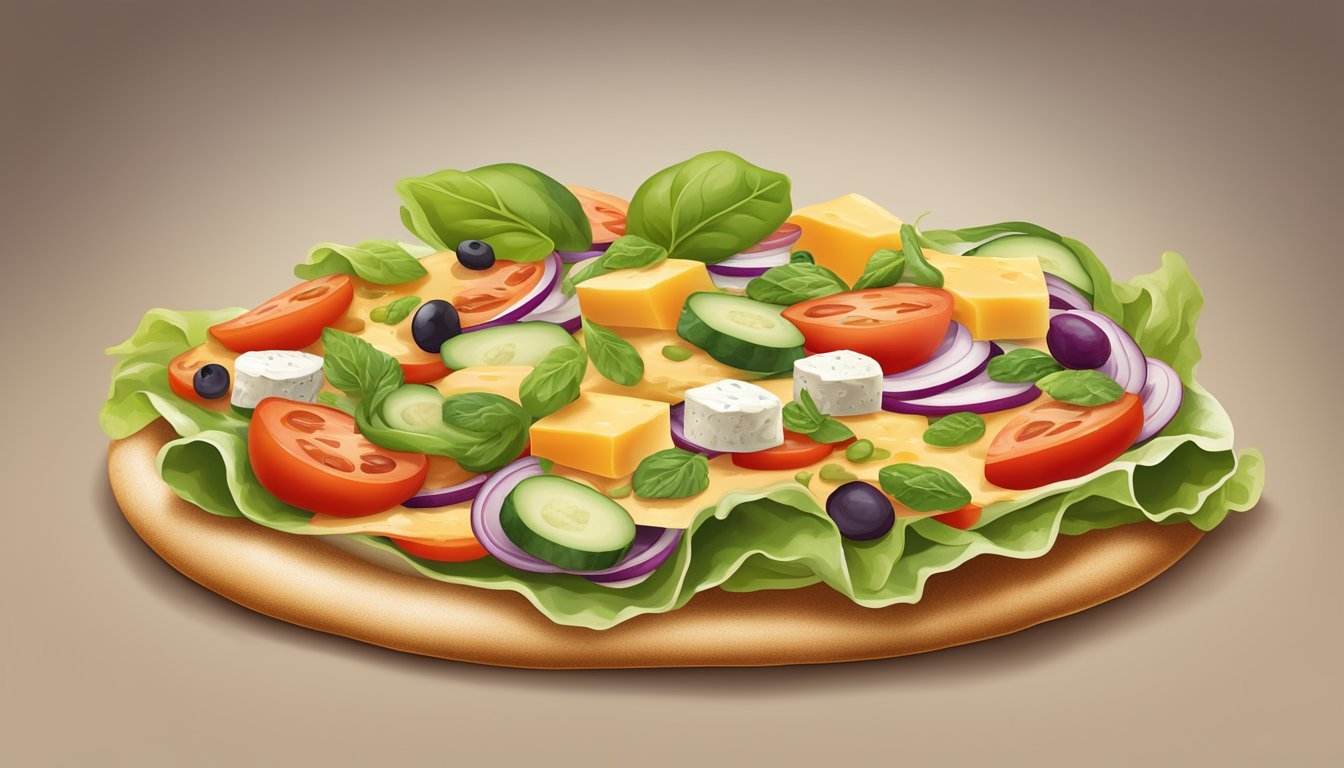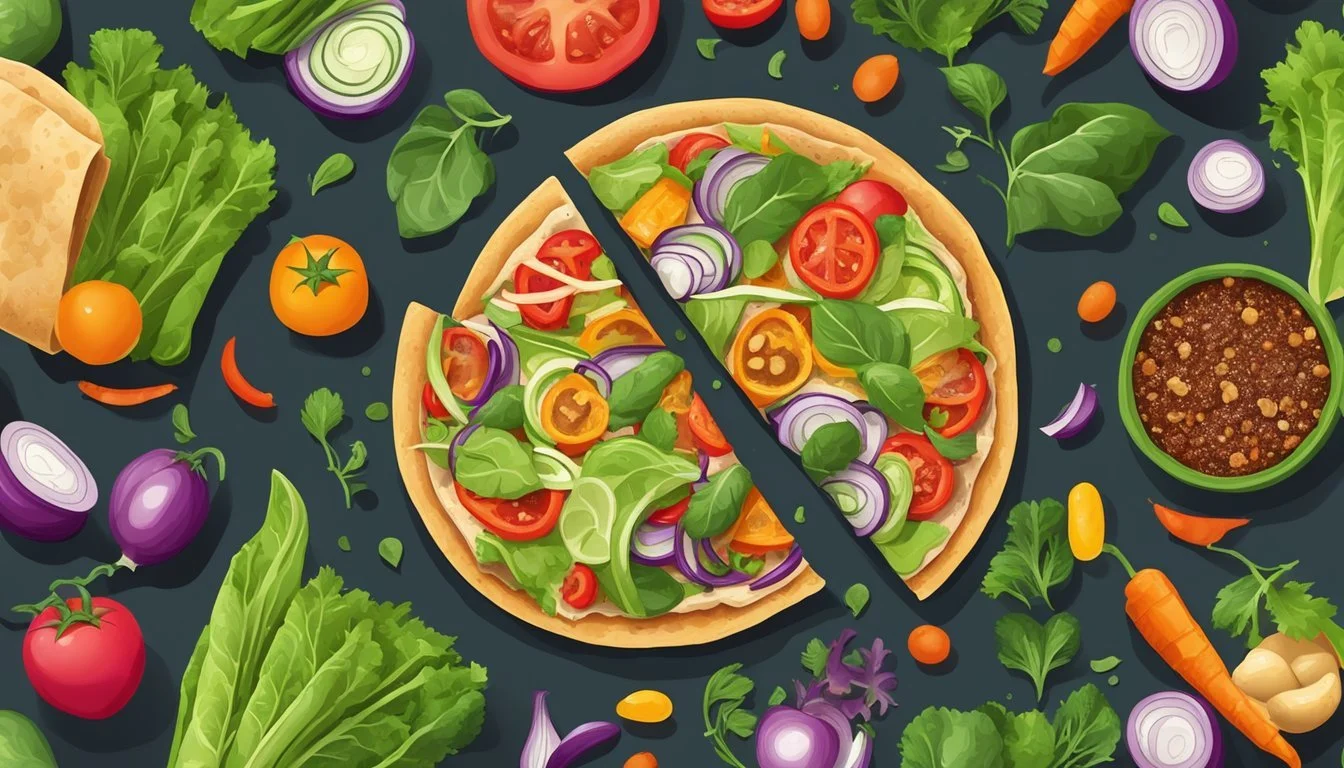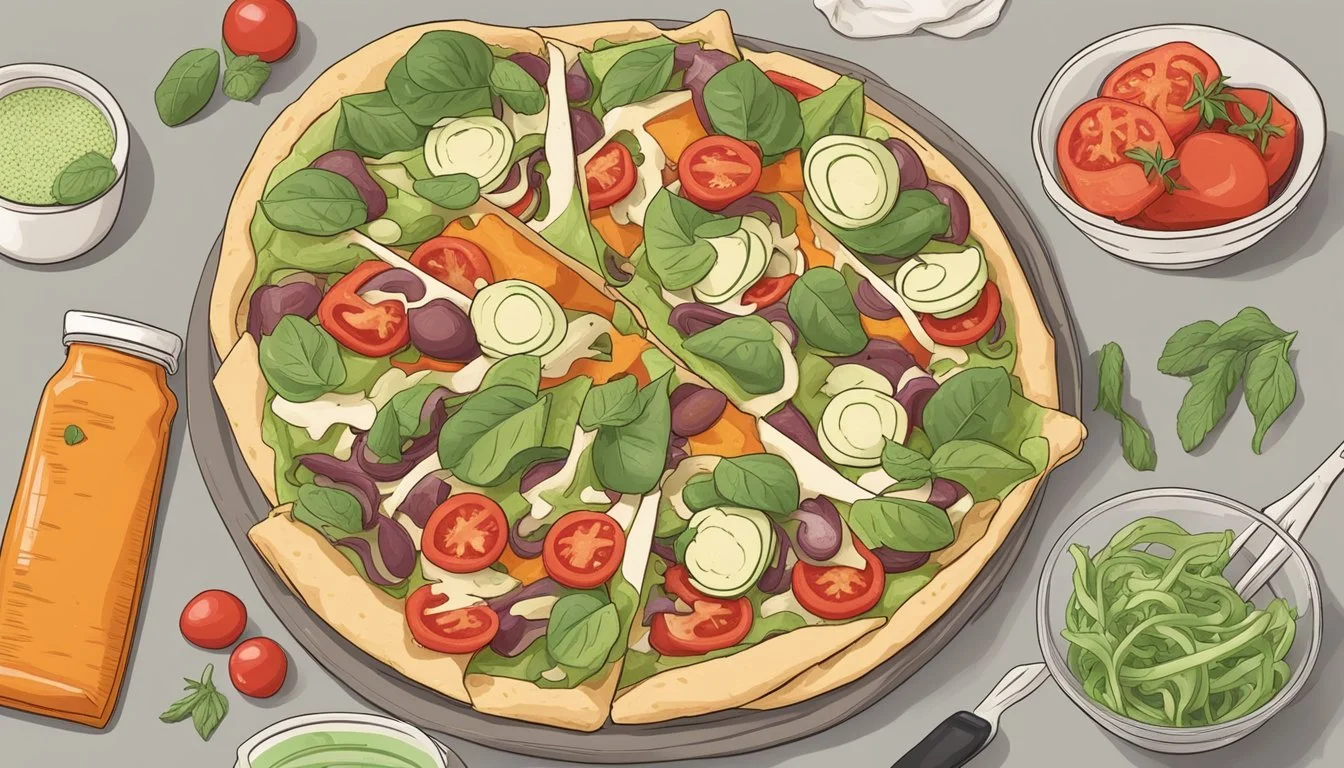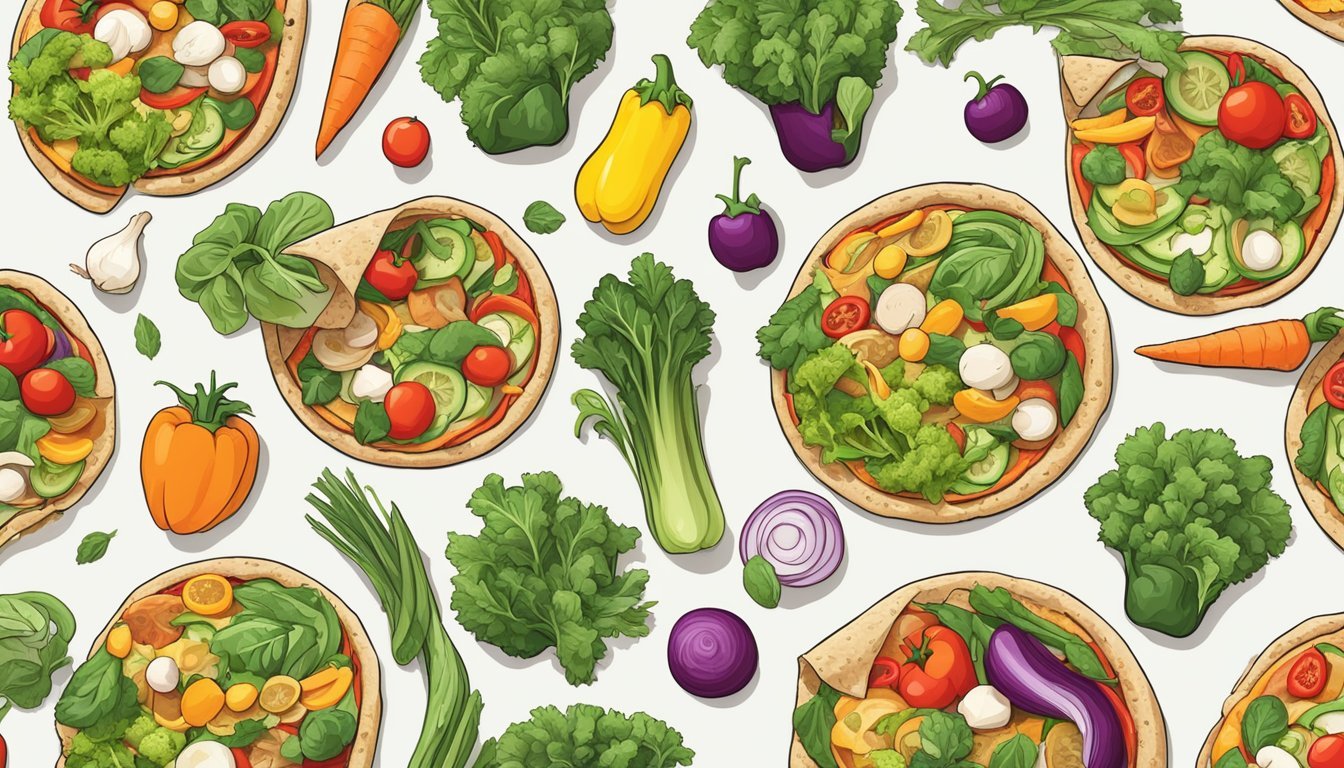Is Pizza Wrap Vegan?
Debunking Myths and Revealing Truths
When considering whether a pizza (What wine goes well with pizza?) wrap is vegan, one must examine the ingredients that go into its creation. A traditional pizza wrap, much like a classic pizza, may contain non-vegan items such as cheese and meats. However, vegan pizza wraps are indeed a possibility and are becoming increasingly popular as more people turn to plant-based diets. By substituting animal products with vegetable alternatives and plant-derived ingredients, pizza wraps can be enjoyed by vegans.
The key to a vegan pizza wrap lies in the selection of components that eschew animal derivatives for vegetables, legumes, and non-dairy cheese replacements. Typical vegan pizza wrap fillings can include an array of vegetables like bell peppers and mushrooms, legumes such as chickpeas and white beans, and seasonings to add depth of flavor. To bind these ingredients, vegan sauces and spreads can be employed, ensuring that the final product maintains the integrity of traditional pizza flavors while adhering to vegan standards.
With the rise of dietary restrictions and preferences, the availability of vegan alternatives to classic dishes has expanded. Restaurants, food blogs, and home cooks are now offering creative vegan takes on pizza wraps that are both satisfying and aligned with vegan eating principles. These versions not only cater to those following a strict vegan lifestyle but are also an inviting option for those looking to reduce their meat intake or simply explore the richness of plant-based cuisine.
What Is a Pizza Wrap?
In the landscape of fusion cuisine, the pizza wrap stands out as a convenient twist on traditional pizza, offering a hand-held dining experience with all the delicious flavors of pizza enveloped in a tortilla.
Defining Pizza Wrap
A pizza wrap is a culinary hybrid that marries the concept of a wrap with the flavorful components of a pizza. The base of a pizza wrap is typically a tortilla, which is laid flat and often cut halfway up the middle to create quadrants for an even distribution of ingredients. The filling is composed of traditional pizza toppings (What wine goes well with pizza toppings?) – any combination of sauces, cheeses, meats, and vegetables.
Vegan Pizza Wrap Essentials
For a wrap to be classified as vegan, it must exclude all animal products. A vegan pizza wrap relies on plant-based ingredients. The essential components include:
Tortillas: Should be free of animal-derived ingredients such as lard.
Sauce: Typically tomato-based or sometimes a vegan pesto.
Cheese: Dairy-free cheese alternatives made from nuts or soy.
Toppings: A variety of vegetables, legumes like white beans or chickpeas, and vegan proteins such as tofu or meat substitutes.
Ingredient Vegan Requirement Tortillas Must not contain lard or dairy Cheese Must be plant-based Toppings Excludes meat, dairy, and animal byproducts
Combining these components, the tortilla is then folded or rolled after filling and can be served as it is, or heated through to melt the cheese and meld the flavors.
Vegan Ingredients Overview
When crafting a vegan pizza wrap, selecting key plant-based ingredients and substitutes ensures the final product is both delicious and adheres to a vegan diet. This section focuses on popular ingredients that can be used to create a satisfying vegan pizza wrap.
Common Vegan Substitutes for Pizza Wraps
For the base of any vegan pizza wrap, common substitutes are essential to replicate the flavors and textures of traditional pizza ingredients. Crusts can be replaced with a variety of tortillas or specially-made vegan wrap bread. Olive oil is often used to add richness to the wrap, while tomato sauce or marinara sauce form the fundamental flavor base, ensuring that they are made without any animal products.
Protein sources: Instead of traditional meats, opt for ingredients like marinated white beans, chickpeas, or tofu.
Vegetables: A colorful array of vegetables like bell peppers, mushrooms, kale, sun-dried tomatoes, and zucchini can add nutrition and flavor.
Herbs and spices: To season, use fresh basil, oregano (dried or fresh), garlic powder, and crushed red pepper flakes for a depth of flavor.
Vegan Cheese Options
A critical component to achieving the desired gooey texture and creamy taste in pizza wraps is vegan cheese. Vegan mozzarella is a popular choice because of its mild flavor and meltability.
Here is a simple table of vegan cheese varieties suited for pizza wraps:
Vegan Cheese Type Flavor Profile Meltability Vegan Mozzarella Mild, creamy High Cashew-Based Cheese Rich, buttery Medium Almond-Based Cheese Nutty, delicate Medium Soy-Based Cheese Light, versatile Varies
Using nutritional yeast can also add a cheese-like flavor to pizza wraps, and it's often incorporated directly into the sauce or sprinkled on top like grated cheese. When choosing a vegan cheese, one should consider the desired taste and how well the cheese melts, as some options may perform better than others when heated in a wrap.
Health Benefits of Vegan Pizza Wraps
Vegan pizza wraps offer a nutritious alternative for those seeking a meal that balances taste with health. They are typically rich in essential nutrients while being lower in unhealthy fats and sodium compared to traditional pizza options.
Nutritional Considerations
A well-composed vegan pizza wrap is beneficial because it often contains a variety of vegetables which boost the intake of dietary fiber and essential vitamins. These wraps can include ingredients like bell peppers, mushrooms, and leafy greens, increasing the overall nutrient density. Whole grains used in the tortilla wrap add to the fiber content, which is instrumental in maintaining gut health and satiety.
Ingredients such as white beans or chickpeas not only provide a hearty texture but are also excellent sources of plant-based protein. They contribute significantly to the protein content, which is vital for muscle repair and growth. Moreover, using nutritional yeast adds a cheesy flavor while providing B vitamins, including B12, a nutrient of concern in vegan diets.
Protein: Essential for muscle repair and growth
Fiber: Promotes digestive health and feelings of fullness
Unsaturated fats: May come from olive oil, contributing to heart health
Balancing Calories and Nutrients
When considering calorie content, vegan pizza wraps can be portion-controlled easily, allowing one to manage caloric intake effectively. They usually have less saturated fat than traditional pizzas since they do not contain cheese made from animal milk.
The presence of unsaturated fats, typically from olive oil, is advantageous for cardiovascular health. Whole food ingredients minimize the presence of trans fats and help balance the overall fat profile.
Here's the nutrient breakdown in general terms:
Calories: Can be adjusted based on wrap size and fillings
Carbohydrates: Source mainly from the wrap and vegetables, providing energy
Fats: Primarily unsaturated from olive oil and certain plant-based ingredients
Sodium: Tends to be lower than in traditional pizzas, especially with homemade sauce
Saturated fat: Minimized without the use of animal-based cheese
By choosing whole-grain wraps and nutrient-rich fillings, one can craft a vegan pizza wrap that is not only delicious but also aligns with a health-conscious diet.
Making a Vegan Pizza Wrap
Crafting a vegan pizza wrap combines the convenience of a wrap with the flavors of classic pizza. It’s a simple process that involves preparing a variety of plant-based ingredients and cooking them to create a quick and savory meal.
Step-by-Step Preparation
Ingredients:
Tortilla wraps
Olive oil
Bell peppers, sliced
Mushrooms, sliced
Fresh basil, chopped
Balsamic vinegar
Salt
Black pepper
Paprika
Nutritional yeast
Marinara sauce
White beans, rinsed and drained
Optional toppings: chickpeas, crushed fennel seeds, dried basil, dried oregano, garlic powder, almond meal
Prep time: Approximately 10 minutes.
Begin by gathering all the necessary ingredients for the wrap.
Rinse and drain white beans and chickpeas if using.
Wash and slice bell peppers and mushrooms.
Chop fresh basil to enhance flavor.
Cooking Instructions
Cook time: Roughly 12 minutes.
Servings: Varies depending on the number of wraps made.
Heat a tablespoon of olive oil in a skillet over medium heat.
Add bell pepper, mushrooms, basil, balsamic vinegar, salt, pepper, paprika, and nutritional yeast.
Stir and cook the mixture for 8 minutes until the vegetables are softened and aromatic.
Stir in marinara sauce and white beans, cooking for an additional 3 minutes until everything is heated through.
While the filling cooks, heat tortillas in the microwave for 30 seconds or until pliable.
Lay out the warm tortillas and distribute the cooked filling evenly among them.
Roll each tortilla tightly, burrito-style, being careful not to overfill.
Optional:
For added texture, some recipes suggest including chickpeas seasoned with fennel seeds, dried basil, oregano, and garlic powder.
Almond meal can be sprinkled on for additional flavor and nutrients.
Once rolled, the wraps can be placed in a preheated oven at 425 degrees F (218 C) for a crispy exterior. Monitor closely and cook for 5-7 minutes.
In preparing vegan pizza wraps, they focus on assembling fresh ingredients and simple cooking techniques for a nutritious and satisfying meal. The wrap should be rolled securely to hold all ingredients, and it may be placed in an oven for a few minutes to achieve a toasted texture.
Tasteful Toppings and Variations
When crafting a vegan pizza wrap, the incorporation of a range of toppings and sauce variations is key to creating a delicious and satisfying experience. Here, we'll look at some specific toppings that can enhance the flavor profile of your wrap, as well as imaginative sauce ideas to elevate the dish.
Exploring Different Toppings
The choice of toppings can make or break a vegan pizza wrap. For a burst of flavor, dried herbs such as oregano, basil, rosemary, and thyme offer an aromatic touch. Garlic powder is a convenient way to infuse a garlic kick without the need to roast cloves. Consider the following toppings to add texture and depth:
Bell peppers: These provide a sweet and slightly tangy crunch.
Mushrooms: A staple for their meaty texture.
Pineapple: Controversial to some, but it adds a sweet and acidic punch.
Vegan sausage: For those seeking a hearty bite.
Cranberries or orange slices: These can add a unique, tangy twist.
Each ingredient contributes to a complex flavor profile while keeping the integrity of a vegan dish.
Creative Sauce Ideas
Sauces are essential as they act as the flavor foundation for any pizza wrap. Beyond the traditional tomato-based marinara, one could explore:
Pesto: made with fresh basil, garlic, nutritional yeast, and pine nuts or walnuts to replace cheese.
Hummus: A creamy spread that provides a rich and earthy base.
Experimenting with sauces elevates the wrap from ordinary to exceptional, offering an array of flavors to entice the palate.
Special Dietary Considerations
For individuals requiring specialized diets due to health or ethical reasons, there are both vegan and gluten-free pizza wraps options available. It's important to consider ingredient substitutions to cater to these dietary needs.
Gluten-Free Options
For those with celiac disease or gluten sensitivity, gluten-free options are crucial. Many pizza wrap recipes can be adapted using gluten-free tortillas as the base. Here is a concise list of alternative ingredients:
Tortillas: Choose tortillas made from gluten-free flour like rice, corn, or almond.
Flour for dusting: Use gluten-free flour blends instead of wheat flour.
Baking powder: Ensure it's labeled gluten-free to avoid cross-contamination.
One should always verify that any additional fillers or sauces included in the pizza wrap are also free from gluten.
Reducing Allergens in Pizza Wraps
Allergen management is a serious concern for many individuals. Here are some common allergens that may be present in pizza wraps and suggested substitutions:
Cheese: Opt for vegan cheese varieties that are soy-free if soy is a concern.
Sauces: Read labels to ensure sauces are devoid of hidden allergens like nuts or dairy.
Substituting ingredients may require careful consideration of the allergen profile of each substitute to ensure the pizza wrap remains safe to consume for those with specific allergies.
Finishing Touches and Serving Recommendations
In the realm of vegan pizza wraps, the final garnishes and complementary sides are crucial for a complete and flavorful experience. These finishings add not only visual appeal but layers of taste profiles that elevate the dish.
Garnishing for Enhanced Flavor
Garnished thoughtfully, a vegan pizza wrap transforms into a flavorful delight. Sprinkle fresh basil leaves for a herby freshness, or add arugula or spinach for a peppery and nutritious boost. Finely chopped red onion introduces a sharp and slightly sweet dimension. To accentuate the flavors, a light drizzle of olive oil can offer richness, and a dusting of Italian seasoning or crushed fennel seeds can give a robust and unmistakable Italian flair.
Fresh Basil: Aromatic and sweet with a slight peppery edge.
Arugula/Spinach: Peppery arugula or mild spinach adds a fresh and nutritious component.
Red Onion: Offers a sharp but sweet note.
Olive Oil: Contributes a rich and fruity undertone.
Italian Seasoning: A mix of herbs that provides classic Italian taste.
Fennel Seeds: Anise-like flavor that adds a unique Italian sausage-like note.
Pairs Well With
A vegan pizza wrap is versatile and pairs beautifully with various sides and dips. For a wholesome meal, consider a side of marinated olive oil and balsamic vinegar-dressed mixed greens. A tangy avocado dip can compliment the wrap's filling, providing a creamy texture and buttery taste. Serve with a sparkling water infused with fresh flavorings like basil or citrus to cleanse the palate between bites.
Mixed Greens Salad: Dressed in olive oil and balsamic, a simple yet refined side.
Avocado Dip: Creamy complement to the vegan wrap's textures and flavors.
Sparkling Water: Refreshing and palate-cleansing, optionally infused with fresh basil or citrus.
Common Vegan Pizza Wrap Mistakes to Avoid
When crafting a vegan pizza wrap, it is crucial to consider both the ingredients used and the cooking methods applied. These two aspects can profoundly affect the texture and flavor of the final product.
Ingredient Selection
One should carefully select high-quality ingredients, as this is the foundation of a flavorful vegan pizza wrap. Common errors in ingredient selection include:
Using non-vegan ingredients inadvertently, such as standard tortillas that may contain lard or cheeses that contain casein. Always read labels to ensure that all components are indeed vegan.
Overlooking the importance of a crispy texture. For a desirable crispness, one might choose tortillas that are known to brown well when heated and use toppings that won't release too much moisture.
Selecting the wrong cheese alternative. Some vegan cheeses do not melt as expected, which can lead to a less satisfying wrap. Look for a vegan cheese that melts well and complements the other flavors in your wrap.
Cooking Techniques
Proper cooking techniques are pivotal to prevent a soggy or improperly cooked wrap. Key missteps in cooking techniques include:
Failing to preheat the oven if you are transferring your pizza wrap to bake, as a proper pre-heat ensures a crispy exterior.
Neglecting the wrap rolling technique. A tightly rolled pizza wrap helps to evenly distribute the fillings and prevents them from falling out during cooking.
Putting too many toppings or an excessive amount of sauce can result in a wrap that's hard to close or one that becomes soggy. Balance is key.
Not adjusting cooking time for wraps compared to traditional pizza. Because a wrap has a different thickness and moisture content than a pizza crust, they typically require less time in the oven.
Storing and Reheating Tips
Proper storage and reheating are essential to maintain the freshness and healthful qualities of a pizza wrap. These methods ensure that a pizza wrap retains its best flavor and texture when it's time to enjoy it again.
Optimal Storage Methods
For optimal storage, one must place the pizza wrap in an airtight container before refrigerating. This prevents moisture loss and keeps the wrap fresh. It's recommended to store pizza wraps on the top shelf of the refrigerator, where the temperature is most consistent. To maintain a pizza wrap's quality, it should be consumed within 3-4 days.
Reheating for Best Quality
When reheating a pizza wrap, the goal is to restore its original texture and temperature without compromising its quality.
Oven Reheating:
Preheat an oven to 375 degrees Fahrenheit.
Place the pizza wrap on a baking sheet.
Heat for 10-15 minutes or until thoroughly warmed.
Microwave Reheating:
Set the pizza wrap on a microwave-safe plate.
Reheat on high for 1-2 minutes or until the cheese has melted.
Stovetop Reheating:
Heat a skillet over medium heat.
Add the pizza wrap and cook for 5-7 minutes per side or until suitably hot.
Using these methods, one ensures the pizza wrap is reheated evenly, retaining its taste and texture.
Exploring Vegan Pizza Wrap Alternatives
Vegan pizza wraps have evolved as a delicious and convenient alternative to traditional pizza, combining the hand-held convenience of a wrap with the flavors of vegan pizza.
Burrito-Inspired Variations
The vegan burrito-style pizza wrap is a heartier take on the wrap concept. It typically involves a large tortilla filled with an array of vegetables, vegan proteins like sofritas (a spicy tofu mixture), and non-dairy cheese alternatives. For those seeking a punch of flavor, adding a sprinkle of vegan parmesan can mimic the savory notes often associated with cheese.
Ingredients:
Vegan proteins (sofritas, beans)
Assorted vegetables (bell peppers, mushrooms)
Dairy-free cheese substitutes
Tortillas (whole wheat, corn)
Preparation:
Sauté vegetables and proteins with spices.
Warm the tortilla to make it pliable.
Distribute the filling and fold burrito-style.
Gourmet Vegan Wrap Ideas
Gourmet vegan wrap pizzas step outside the box, featuring more upscale ingredients and creative combinations. They often include specialty plant-based cheeses and a variety of mushrooms, providing a depth of flavor and a satisfying umami kick. These wraps can be garnished with balsamic glaze or truffle oil for an elevated dining experience.
Toppings:
Gourmet mushrooms (shiitake, portobello)
Premium vegan cheeses (cashew-based, almond)
Fresh herbs (basil, oregano)
Artisanal sauces (pesto, marinara)
Techniques:
Roast or grill the mushrooms for intensified taste.
Use a panini press to crisp the wrap and meld the flavors.


